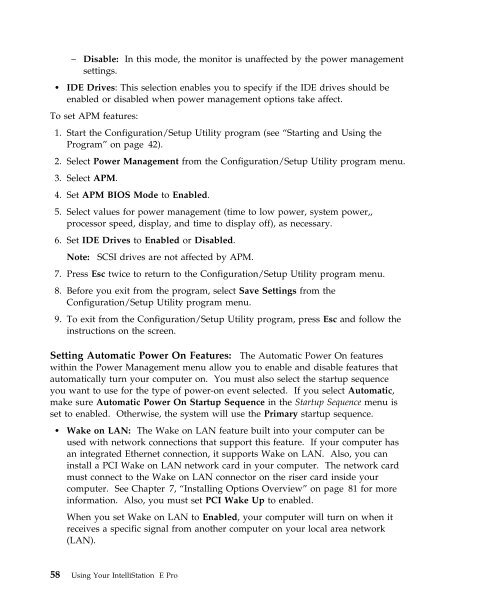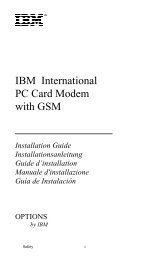IntelliStation E Pro User Guide Professional ... - FTP Directory Listing
IntelliStation E Pro User Guide Professional ... - FTP Directory Listing
IntelliStation E Pro User Guide Professional ... - FTP Directory Listing
You also want an ePaper? Increase the reach of your titles
YUMPU automatically turns print PDFs into web optimized ePapers that Google loves.
– Disable: In this mode, the monitor is unaffected by the power management<br />
settings.<br />
� IDE Drives: This selection enables you to specify if the IDE drives should be<br />
enabled or disabled when power management options take affect.<br />
To set APM features:<br />
1. Start the Configuration/Setup Utility program (see “Starting and Using the<br />
<strong>Pro</strong>gram” on page 42).<br />
2. Select Power Management from the Configuration/Setup Utility program menu.<br />
3. Select APM.<br />
4. Set APM BIOS Mode to Enabled.<br />
5. Select values for power management (time to low power, system power,,<br />
processor speed, display, and time to display off), as necessary.<br />
6. Set IDE Drives to Enabled or Disabled.<br />
Note: SCSI drives are not affected by APM.<br />
7. Press Esc twice to return to the Configuration/Setup Utility program menu.<br />
8. Before you exit from the program, select Save Settings from the<br />
Configuration/Setup Utility program menu.<br />
9. To exit from the Configuration/Setup Utility program, press Esc and follow the<br />
instructions on the screen.<br />
Setting Automatic Power On Features: The Automatic Power On features<br />
within the Power Management menu allow you to enable and disable features that<br />
automatically turn your computer on. You must also select the startup sequence<br />
you want to use for the type of power-on event selected. If you select Automatic,<br />
make sure Automatic Power On Startup Sequence in the Startup Sequence menu is<br />
set to enabled. Otherwise, the system will use the Primary startup sequence.<br />
� Wake on LAN: The Wake on LAN feature built into your computer can be<br />
used with network connections that support this feature. If your computer has<br />
an integrated Ethernet connection, it supports Wake on LAN. Also, you can<br />
install a PCI Wake on LAN network card in your computer. The network card<br />
must connect to the Wake on LAN connector on the riser card inside your<br />
computer. See Chapter 7, “Installing Options Overview” on page 81 for more<br />
information. Also, you must set PCI Wake Up to enabled.<br />
When you set Wake on LAN to Enabled, your computer will turn on when it<br />
receives a specific signal from another computer on your local area network<br />
(LAN).<br />
58 Using Your <strong>IntelliStation</strong> E <strong>Pro</strong>












